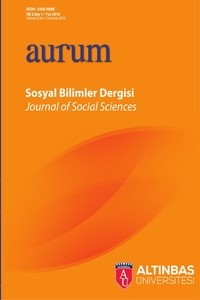Mavi Akım’dan Türk Akım’a Türkiye’nin Rusya’ya Enerji Bağımlılığının Bir Değerlendirmesi
ÖzetTürkiye, Rusya’dan doğalgaz satın alımına Soğuk Savaş’tan önce başlayıp daha sonraki on yıllar için önemlibir ilişkinin tohumlarını atmıştır. Mavi Akım Projesinin inşası Moskova’nın Türkiye için ana tedarikçi konumunusağlamlaştıran bir dönüm noktasıdır. Rusya’nın bu hakimiyetinin hafifletilmesi için gösterilen çabalara rağmenGazprom Türkiye’nin toplam tüketiminin yarısından fazlasını kontrol etmektedir. Rusya ve Türkiye’yi doğrudanbağlayacak Türk Akım boru hattı bu koşullarda sürdürülmektedir ve sadece Türk tüketicilerini hedeflemeklekalmayıp Avrupa’ya transit ulaşma imkanı sağlayabilecektir. Mavi Akım hattı anlaşmasının imzalanmasındanyirmi yıl sonra, bu iki projenin karşılaştırması Ankara’nın Rusya’ya olan enerji bağımlılığını anlaşılması içinaydınlatıcı olabilecektir.
Anahtar Kelimeler:
Mavi Akım, Türk Akım, Rusya-Türkiye enerji ilişkileri, boru hattı siyaseti, enerji bağımlılığı
From Blue Stream To Turkish Stream An Assesment Of Turkey’s Energy Dependence On Russia
AbstractTurkey started imports of natural gas from Russia before the Cold War ended, establishing the basis of animportant relationship for decades to come. Construction of Blue Stream pipeline was a major landmark afterwhich Moscow consolidated its position as the major supplier for Turkish market. Despite efforts to diluteRussia’s dominance in natural gas imports, Gazprom still controls more than half of Turkey’s total consumptiontoday. Turkish Stream pipeline, that will directly link Russia with Turkey, is being constructed under thesecircumstances even though the project does not solely target Turkish consumers but aims to reach Europeanmarket in transit from Turkey. Two decades after the signing of Blue Stream contract, a comparison betweenthose projects may explain how Ankara has fared with its energy dependence on Russia.
Keywords:
Blue Stream, Turkish Stream, Russia-Turkey energy relations, pipeline politics, energy dependence,
___
- Aslund, A. (1998). Russia’s Financial Crisis: Causes and Possible Remedies. Post-Soviet Geography and Economics, 6, 309-328.
- Austvik, O. G., & Rzayeva, G. (2016). Turkey in the Geopolitics of Natural Gas. Boston: M-RCBG Associate Working Paper Series.
- Babalı, T. (2009). Turkey, Present and Past: Turkey at the Energy Crossroads. Middle East Quarterly, 16(2), 25-33.
- Bacik, G. (2001). The Blue Stream project, energy co-operation and conflicting interests. Turkish Studies, 2(2), 85-93.
- Balat, M. (2010). Security of Energy Supply in Turkey: Challenges and Solution, Energy Conversion and Management, 51(10), 1998-2011
- Baran, Z. (2007). EU energy security: time to end Russian leverage. Washington Quarterly, 30(4), 131-144.
- Belkin, P., Nichol, J., & Woehrel, S. (2013). Europe’s Energy Security: Options and Challenges to Natural Gas Supply Diversification. Washington DC: Congressional Research Service.
- Bilgin, M. (2010). Turkey’s Energy Strategy: What Difference Does it Make to Become an Energy Transit Corridor, Hub or Center? UNISCI Discussion Papers.
- Bilgin, M. (2015). Turkey’s Energy Strategy: Synchronizing Geopolitics and Foreign Policy with Energy Security. Insight Turkey, 17(2), 57-65.
- Cornell, S. E. (1998). Turkey and the conflict in Nagorno Karabakh: a Delicate Balance. Middle Eastern Studies, 34(1), 51-72.
- Çalış, Ş. (2001). Turkey’s Balkan Policy in the Early 1990s. Turkish Studies, 2(1), 135-146.
- David, G. V., Jaffe, A. M., & Hayes, M. H. (2006). Natural Gas and Geopolitics: From 1970 to 2040. Cambridge: Cambridge University Press.
- Goldthau, A., & Sitter, N. (2015). Soft Power with a Hard Edge: EU Policy Tools and Energy Security. Review of International Political Economy, 22(5), 941-965.
- Hinnebusch, R. (2015). Back to Enmity: Turkey-Syria relations since the Syrian Uprising. Orient, Journal of German Orient Institute, 56(1), 14-22.
- Kalicki, J. H. (2001). Caspian Energy at the Crossroads. Foreign Affairs, 80(5), 120-134.
- Karaosmanoğlu, A. (2001). Turkey’s Objectives in the Caspian Region. International Affairs, 54(1), 203.
- Kruyt, B., van Vuuren, D. P., de Vries, H.J.M. and Groenenberg, H. (2009). Indicators for energy security. Energy Policy, 37 (6): 2166-2181.
- Nuttall, William J. and Manz, Devon L. (2008). A new energy security paradigm for the twenty-first century. Technological Forecasting and Social Change, 75(8): 1247–1259.
- Oktav, Ö. Z. (2005). American Policies towards the Caspian Sea and the Baku-Tbilisi-Ceyhan Pipeline. Perceptions (Spring Issue), 17-34.
- Paillard, C.-A. (2010). Russia and Europe’s Mutual Energy Dependence. Journal of International Affairs, 63(2), 65-84.
- Quirk, P. W. (2017). Russia–Syria Internal Threat Alliance (2010–2016). in P. W. Quirk ed. Great Powers, Weak States, and Insurgency (p. 179-213). Cham: Palgrave Macmillan.
- Ritz, R. A. (2018). A Strategic Perspective on Competition between Pipeline Gas and LNG. Cambridge: Energy Policy Research Group.
- Rutland, P. (2008). Russia as an Energy Superpower. New Political Economy, 13(2), 203-210.
- Schaffer, B. (2005). From Pipedream to Pipeline: a Caspian Success Story. Current History, 104(684), 343-346.
- Schubert, S. R., Pollak, J., & Brutshin, E. (2014). Two Futures: EU-Russia Relations in the Context of Ukraine. European Journal of Futures research, 2, 52.
- Vygon, G., Ermakov, V., Belova, M., & Kolbikova, E. (2015). Turkish Stream: Scenarios of Bypassing Ukraine and Barriers of European Commission. Moscow: Vygon Consulting.
- Winrow, G. (2004). Turkey and the East‐West Gas Transportation Corridor. Turkish Studies, 5(2), 23-42.
- Winrow, G. M. (2013). The Southern Gas Corridor and Turkey’s Role as an Energy Transit State and Energy Hub. Insight Turkey, 15(1), 145-163.
- Yafimava, K. (2015). European Energy Security and the Role of Russian Gas: Assessing the Feasibility and the Rationale of Reducing Dependence. Milan: Istituto Affari Internazionali.
- Yergin, D. (2006). Ensuring Energy Security. Foreign Affairs. 85 (2): 69-82.
- ISSN: 2458-9896
- Yayın Aralığı: Yılda 2 Sayı
- Başlangıç: 2016
- Yayıncı: Altınbaş Üniversitesi
Sayıdaki Diğer Makaleler
“Nereye Aitiz?” Diasporik Kimlik ve Türk Vatandaşlığı Kıskacında Çerkes Kimliği
RETURNED: GOING AND COMING IN THE AGE OF DEPORTATION
Pay Sahibinin Anonim Şirket Birleşmelerinden Doğan Çıkma Hakkı
Baba, Hukuk ve Kaybedilen Çocuklar: Üç Film Üzerinden Bir Hukuk Kurgusu İncelemesi
PRISONS IN THE LATE OTTOMAN EMPIRE: MICROCOSMS OF MODERNITY KENT F. SCHULL
Ekonomik Sıkıntı, Sosyal Destek ve Depresyon: Türkiye Örneği
Ayşe Yetiş BAYRAKTAR, İşık A. AYTAÇ, Bruce H. RANKIN
Mavi Akım’dan Türk Akım’a Türkiye’nin Rusya’ya Enerji Bağımlılığının Bir Değerlendirmesi
4. Uluslararası Mardin Bienali: Sözden Öte
